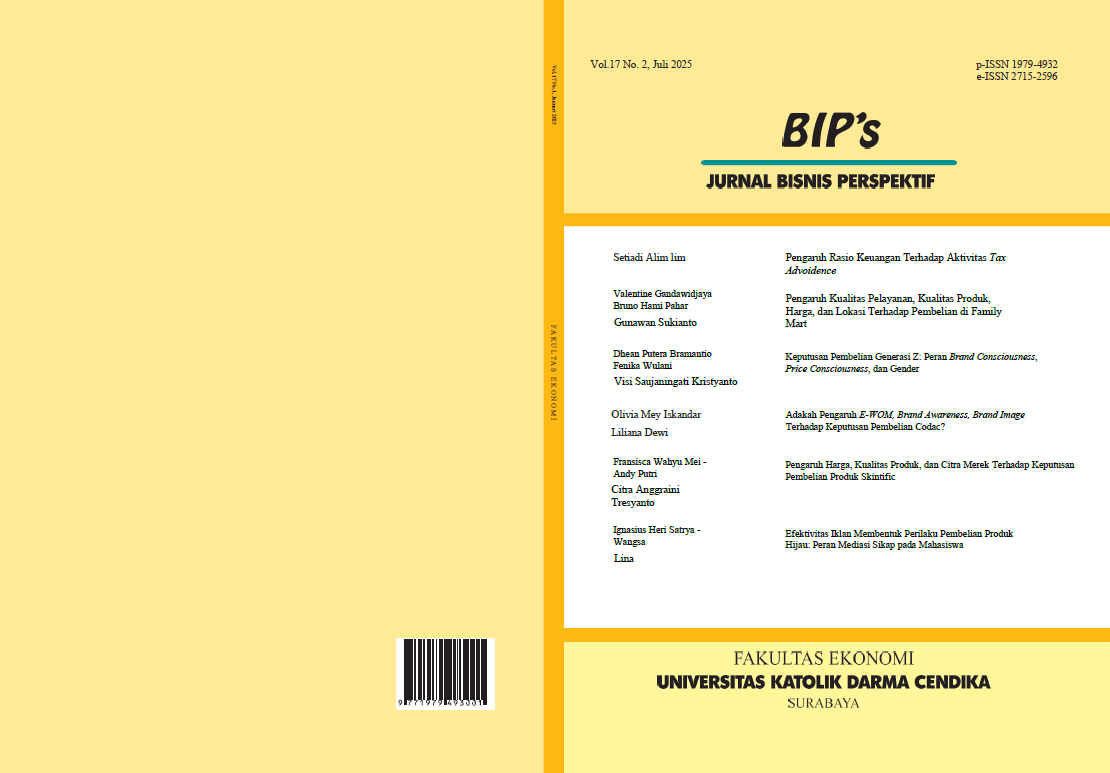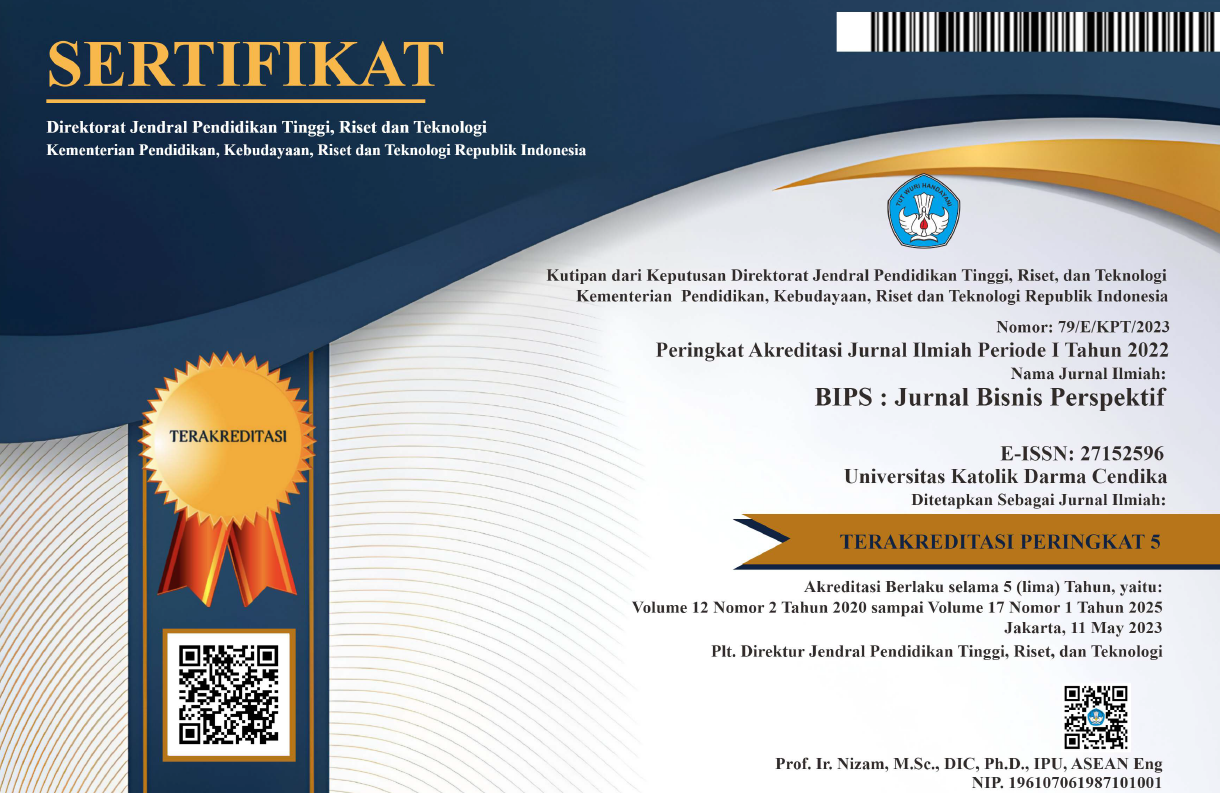Efektivitas Iklan Dalam Membentuk Perilaku Pembelian Produk Hijau Melalui Peran Mediasi Sikap Pada Mahasiswa di Kota Palembang
DOI:
https://doi.org/10.37477/bip.v17i2.790Keywords:
advertisement, green marketing, attitude, mediationAbstract
This study aims to analyze the effectiveness of advertising in shaping green product purchasing behavior through the mediating role of consumer attitudes. Referring to the Theory of Planned Behavior and Signaling Theory, this study highlights two main aspects of advertising—exposure and credibility—in influencing consumer decisions towards environmentally friendly products. The study uses a quantitative approach with the Structural Equation Modeling - Partial Least Squares (SEM-PLS) analysis technique, based on data from 55 student respondents aged 18–24 years in Palembang City, Indonesia. The results show that advertising credibility has a significant effect on consumer attitudes, which then influence green product purchasing behavior. Conversely, advertising exposure has a direct effect on purchasing behavior, but does not significantly shape attitudes. Attitude is proven to be a significant mediator between advertising credibility and green product purchases, but does not act as a mediator between advertising exposure and purchases. These findings emphasize the importance of building trust through credible advertising, rather than relying solely on the frequency of exposure. In the context of green marketing, message credibility plays a key role in shaping positive consumer attitudes that drive sustainable purchasing behavior. In practice, marketers need to emphasize transparency, authenticity, and concrete evidence in delivering green advertising. The study also recommends further exploration of other psychological or demographic factors that can strengthen the effectiveness of green marketing communication strategies across consumer segments.
References
Ahmed, M., Ashfaq, A., & Yousaf, S. (2024). Environmental consciousness and green purchase behavior: Moderating roles of green advertising exposure. Journal of Cleaner Production, 424, 139152. https://doi.org/10.1016/j.jclepro.2024.139152
Ali, I., & Ahmad, M. (2024). Green advertising exposure and consumer purchase decisions: An empirical study. Journal of Business Research, 170, 126–135.
Ajzen, I. (2024). Theory of planned behavior and sustainable consumer decisions: Advances and new directions. Journal of Consumer Psychology, 34(1), 1-15. https://doi.org/10.1016/j.jcps.2023.12.005
Befort, N., Ayoub, M., & Matt, M. (2025). The role of dynamic capabilities in the development of eco- innovations. Current Opinion in Green and Sustainable Chemistry, 101031.
Chen, Y.-S., & Chang, C.-H. (2024). The impact of green advertising appeals on consumer engagement and purchase intentions. Sustainability, 16(3), 1560. https://doi.org/10.3390/su16031560
Chen, H., & Yang, L. (2025). Green innovation and business strategy: A sustainable approach to competitive advantage. Sustainability, 17(5), 1769.
Hair, J. F., Hult, G. T. M., Ringle, C. M., & Sarstedt, M. (2022). A Primer on Partial Least Squares Structural Equation Modeling (PLS-SEM) (4th ed.). SAGE Publications.
Kumar, A., & Polonsky, M. J. (2023). Relevance and effectiveness of advertising appeals in green marketing. Journal of Marketing Communications, 29(4), 421–439.
Li, X., Guo, H., & Wang, J. (2024). Source credibility, environmental message framing, and green consumer behavior. International Journal of Environmental Research and Public Health, 21(4), 2012. https://doi.org/10.3390/ijerph21042012
Liao, C., & Fang, Y. (2024). Exploring the signaling effect of green advertisements on consumer trust and purchase intention. Journal of Business Research, 173, 113515. https://doi.org/10.1016/j.jbusres.2024.113515
Lu, L., Chang, H. H., & Chang, A. (2024). Credibility of environmental advertising and its impact on consumer attitudes. Journal of Cleaner Production, 416, 139150.
Nguyen, T. T., & Hoang, V. N. (2024). Emotional appeal versus informational appeal in green advertising: Effects on consumers' attitudes and intentions. Environmental Communication, 18(2), 211-230. https://doi.org/10.1080/17524032.2024.2175631
Rausch, T. M., & Kopplin, C. S. (2024). Credibility in green advertising: Mediating role of consumer attitudes. Environmental Management Journal, 83(1), 101–110.
Sadiq, M., Khattak, A., & Rehman, Z. U. (2024). Attitude-behavior gap and determinants of sustainable consumption: A systematic review. Resources, Conservation and Recycling, 202, 107918. https://doi.org/10.1016/j.resconrec.2024.107918
Tran, Q., & Lee, J. (2024). Green advertising effectiveness: The moderating role of product involvement and perceived risk. Marketing Intelligence & Planning, 42(1), 127-142. https://doi.org/10.1108/MIP-06-2023-0287
Wu, J., Chen, J., & Wang, L. (2023). Repeated green advertisement exposure and its effect on consumer purchase intentions. International Journal of Advertising, 42(3), 478–497.
Yenipazarli, A., & Vakharia, A. J. (2024). Credibility and direct influence in sustainable marketing campaigns. Business Strategy and the Environment, 33(3), 125–137.
Zhang, X., & Qin, J. (2025). How does a government-certificated green identity improve enterprises’ market value? International Review of Economics & Finance, 101, 104147.
Downloads
Published
How to Cite
Issue
Section
License
Copyright (c) 2025 Ignasius Heri Satrya Wangsa, Lina

This work is licensed under a Creative Commons Attribution-NonCommercial-ShareAlike 4.0 International License.
Authors publishing in this journal agree to the following terms:
- The author retains copyright and grants the journal rights of first publication with the work simultaneously licensed under a Creative Commons Attribution ShareAlike License License that allows others to share the work with acknowledgment of the author's work and initial publication in BIP's: Journal of Business Perspectives.
- Authors may include separate additional contractual arrangements for non-exclusive distribution of the published version of the journal (e.g., submit to an institutional repository or publish in a book), with an acknowledgment of the original publication in this Journal.
- Authors are permitted and encouraged to post their work online (e.g., in institutional repositories or on their websites) before and during the submission process, as it can lead to productive exchanges, as well as citations of previously published work.
Each author is expected to complete the copyright process with a document of the originality of the manuscript, the templated document is below:


7.png)


6.png)
2.png)


